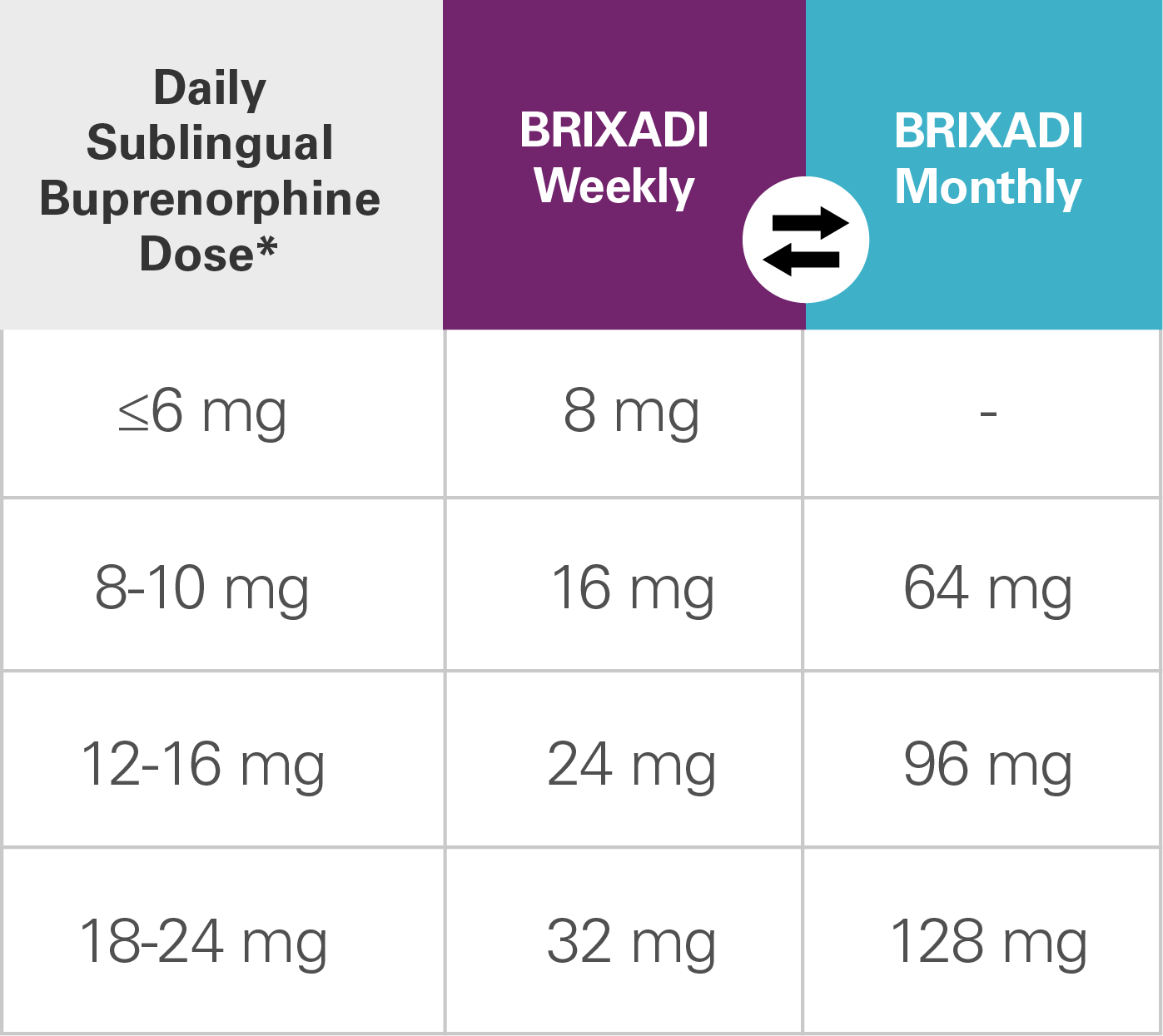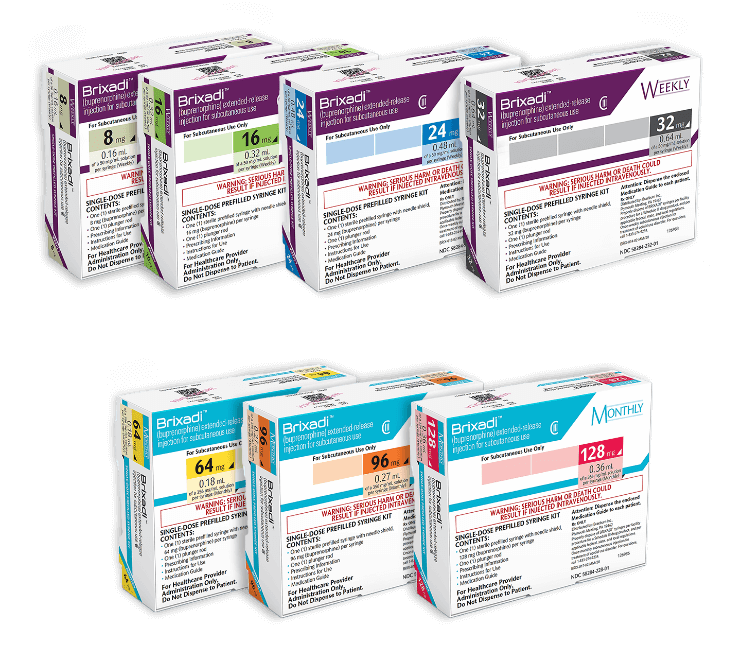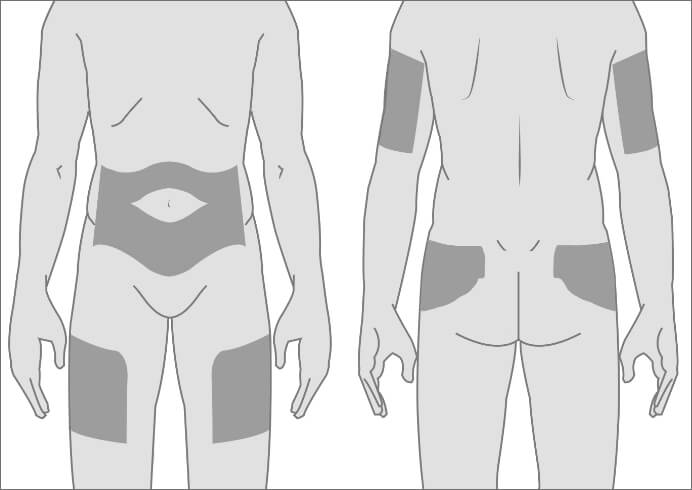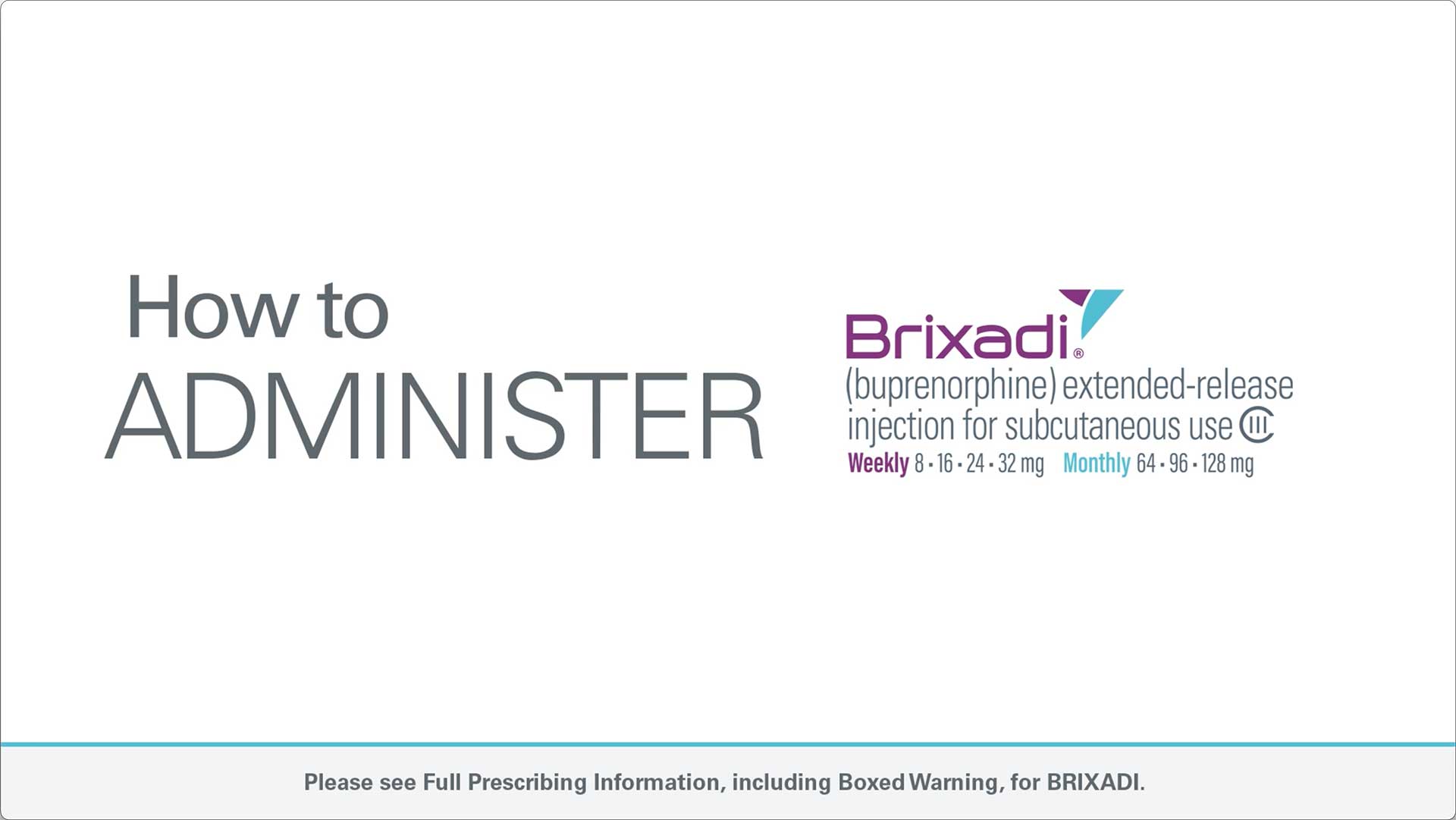Dosing Options
Patients currently on transmucosal buprenorphine treatment can be switched directly to BRIXADI Weekly or BRIXADI Monthly1


*One SUBOXONE® (buprenorphine and naloxone) 8 mg/2 mg sublingual tablet provides equivalent buprenorphine exposure to one SUBUTEX® (buprenorphine HCl) 8 mg sublingual tablet or one Zubsolv® (buprenorphine and naloxone) 5.7 mg/1.4 mg sublingual tablet.1
For patients not currently receiving buprenorphine treatment
- Administer a test dose of transmucosal buprenorphine (4 mg) when objective signs of mild to moderate withdrawal appear
- If the dose is tolerated without precipitated withdrawal, administer the first dose of BRIXADI Weekly 16 mg followed by BRIXADI Weekly 8 mg within 3 days of the first dose. Titrate patients as needed
- Sections 2.1 and 2.3 of the Prescribing Information provide additional important information for these patients1
- When administering BRIXADI Weekly, the upper arm area should only be used after steady state has been achieved (4 consecutive doses)
BRIXADI offers multiple weekly and monthly doses to support individualized treatment


Patients can be transitioned between BRIXADI Monthly and BRIXADI Weekly based on clinical judgment.1
Dosing considerations1
For subcutaneous use only. Do not administer BRIXADI intravenously, intramuscularly, or intradermally.1
BRIXADI is available through a restricted distribution via the BRIXADI REMS Program and is administered only by a healthcare professional.1

BRIXADI Weekly should be administered in 7-day intervals

BRIXADI Monthly should be administered in 28-day intervals

The weekly dose may be given up to 2 days before or after the weekly time point. The monthly dose may be given up to 1 week before or after the monthly time point

Doses of BRIXADI Weekly cannot be combined to yield an equivalent BRIXADI Monthly dose
Download the BRIXADI Dosing Guide
Administering BRIXADI
BRIXADI IS FOR SUBCUTANEOUS INJECTION ONLY1
- DO NOT ADMINISTER BRIXADI INTRAVENOUSLY, INTRAMUSCULARLY, OR INTRADERMALLY
- Only healthcare professionals should prepare and administer BRIXADI
- BRIXADI should be injected slowly into the subcutaneous tissue of the buttock, thigh, abdomen, or upper arm†
- Injection sites should be alternated/rotated between injections for BRIXADI Weekly
†In patients who are not currently receiving buprenorphine treatment, for BRIXADI Weekly, the upper-arm area should only be used after steady state has been achieved (4 consecutive doses). Please refer to Section 2 of the BRIXADI Full Prescribing Information for additional details on dosage and administration.1

Areas of Administration
See how to administer BRIXADI


BRIXADI is available through a restricted distribution via the BRIXADI REMS Program1
Only healthcare professionals should prepare and administer BRIXADI. BRIXADI should never be dispensed directly to a patient because of the serious harm or death that could result from intravenous administration.
Visit the BRIXADI REMS website
BRIXADI has a unique delivery system providing key attributes2
FluidCrystal®‡ Injection Depot Technology allows for1,2:

Needle size:
23 G

Small injection
volume (≤0.64 mL)

Multiple subcutaneous injection areas§

No refrigeration
‡FluidCrystal® trademark is owned by Camurus and used by Braeburn under license.
§The options include buttock, thigh, abdomen, and upper arm. For BRIXADI Weekly, injection sites should be alternated/rotated. In patients who are not currently receiving buprenorphine treatment, for BRIXADI Weekly, the upper-arm area should only be used after steady state has been achieved (4 consecutive doses).1
IMPORTANT SAFETY INFORMATION AND INDICATION
IMPORTANT SAFETY INFORMATION
WARNING: RISK OF SERIOUS HARM OR DEATH WITH INTRAVENOUS ADMINISTRATION; BRIXADI RISK EVALUATION AND MITIGATION STRATEGY
- Serious harm or death could result if administered intravenously. BRIXADI forms a liquid crystalline gel upon contact with body fluids and may cause occlusion, local tissue damage, and thrombo-embolic events, including life-threatening pulmonary emboli, if administered intravenously.
- Because of the risk of serious harm or death that could result from intravenous self-administration, BRIXADI is only available through a restricted program called the BRIXADI REMS. Healthcare settings and pharmacies that order and dispense BRIXADI must be certified in this program and comply with the REMS requirements.
BRIXADI (buprenorphine) extended-release injection (weekly, 50 mg/mL buprenorphine) and BRIXADI (monthly, 356 mg/mL buprenorphine) are different formulations. Doses of BRIXADI (weekly) cannot be combined to yield an equivalent monthly dose.
BRIXADI is contraindicated in patients with hypersensitivity (e.g. anaphylactic shock) to buprenorphine or any other ingredients in the solution for injection.
WARNINGS AND PRECAUTIONS
Addiction, Abuse, and Misuse: BRIXADI contains buprenorphine, a Schedule III controlled substance that can be abused in a manner similar to other opioids. Buprenorphine is sought by people with opioid use disorder and is subject to criminal diversion. Monitor all patients for progression of opioid dependence and addictive behaviors.
Respiratory and CNS Depression: Buprenorphine has been associated with life-threatening respiratory depression and death. Use BRIXADI with caution in patients with compromised respiratory function. Due to its extended-release characteristics, if BRIXADI is discontinued as a result of compromised respiratory function, monitor patients for ongoing buprenorphine effects for approximately 1 month for BRIXADI (weekly) and for approximately 4 months for BRIXADI (monthly). Educate patients and caregivers on how to recognize respiratory depression and emphasize the importance of calling 911 or getting emergency medical help right away in the event of a known or suspected overdose.
Patient Access to Naloxone for the Emergency Treatment of Opioid Overdose: Discuss the availability of naloxone for the emergency treatment of opioid overdose with the patient and caregiver. Because patients being treated for opioid use disorder have the potential for relapse, putting them at risk for opioid overdose, strongly consider prescribing naloxone for the emergency treatment of opioid overdose, both when initiating and renewing treatment with BRIXADI. If naloxone is prescribed, educate patients and caregivers on how to treat with naloxone, and emphasize the importance of calling 911 or getting emergency medical help, even if naloxone is administered.
Concomitant Use of Benzodiazepines or other CNS Depressants: Concomitant use of buprenorphine and benzodiazepines or other CNS depressants increase the risk of adverse reactions including respiratory depression, overdose and death. Ensure that other healthcare providers prescribing benzodiazepines or other CNS depressants are aware of the patient’s buprenorphine treatment and coordinate care to minimize the risk associated with concomitant use. Inform patients and caregivers that potentially fatal additive effects may occur if BRIXADI is used with benzodiazepines or other CNS depressants, including alcohol, and not to use these concomitantly unless supervised by a healthcare provider.
Neonatal Opioid Withdrawal Syndrome, Pregnancy, and Lactation: Neonatal opioid withdrawal syndrome (NOWS) is an expected and treatable outcome of prolonged use of opioids during pregnancy. NOWS may be life-threatening if not recognized and treated in the neonate. Healthcare providers should observe newborns for signs of NOWS and manage accordingly. Advise pregnant women receiving opioid addiction treatment with BRIXADI of the risk of neonatal opioid withdrawal syndrome. Warn patients that buprenorphine passes into breast milk. Advise the nursing mother taking buprenorphine to monitor the infant for increased drowsiness and breathing difficulties.
Adrenal Insufficiency: If adrenal insufficiency is diagnosed, treat with physiologic replacement of corticosteroids, and wean patient off of the opioid.
Risk of Opioid Withdrawal with Abrupt Discontinuation: Patients who elect to discontinue BRIXADI treatment should be monitored for withdrawal signs and symptoms with consideration given to the product’s extended-release characteristics.
Risk of Hepatitis, Hepatic Events, and Use in Patients with Impaired Hepatic Function: Liver function tests should be performed on all patients prior to initiation, during treatment, and if a hepatic event is suspected. Because buprenorphine levels cannot be rapidly decreased, patients with pre‐existing moderate to severe hepatic impairment are not candidates for treatment with BRIXADI. Patients who develop moderate to severe hepatic impairment while being treated with BRIXADI should be monitored for signs and symptoms of toxicity or overdose of buprenorphine and may require a dose adjustment.
Hypersensitivity Reactions: Cases of bronchospasm, angioneurotic edema, and anaphylactic shock have been reported in patients receiving buprenorphine-containing products. The most common signs and symptoms include rashes, hives, and pruritus. The BRIXADI needle cap is synthetically derived from natural rubber latex which may cause allergic reactions in latex-sensitive individuals.
Precipitation of Opioid Withdrawal in Patients Dependent on Full Opioid Agonists: BRIXADI injection may precipitate opioid withdrawal signs and symptoms in individuals physically dependent on full opioid agonists such as heroin, morphine, or methadone before the effects of the full opioid agonist have subsided. In patients who are new entrants to treatment, to avoid precipitating an opioid withdrawal syndrome, administer a 4 mg test dose of transmucosal buprenorphine when objective signs of mild to moderate withdrawal appear and monitor for precipitated withdrawal before injecting BRIXADI.
Risks Associated with Treatment of Emergent Acute Pain: While on BRIXADI, situations may arise where patients need acute pain management, or may require anesthesia. Treat patients receiving BRIXADI with non-opioid analgesic whenever possible. Patients requiring opioid therapy for analgesia may be treated with a high-affinity full opioid analgesic under the supervision of a healthcare provider, with particular attention to respiratory function. Higher doses may be required for analgesic effect. Therefore, a higher potential for toxicity exists with opioid administration. Advise patients of the importance of instructing their family members, in the event of emergency, to inform the treating healthcare provider or emergency room staff that the patient is being treated with BRIXADI.
Use in Opioid Naïve Patients: There have been reported deaths of opioid naïve individuals who received a 2 mg dose of buprenorphine as a sublingual tablet. BRIXADI is not appropriate for use in opioid naïve patients.
Patients at Risk for Arrhythmia: Thorough QT studies with buprenorphine products have demonstrated QT prolongation ≤ 15 msec. This QTc prolongation effect does not appear to be mediated by hERG channels. Based on these two findings, buprenorphine is unlikely to be pro-arrhythmic when used alone in patients without risk factors. The risk of combining buprenorphine with other QT-prolonging agents is not known.
Impairment of Ability to Drive and Operate Machinery: BRIXADI may impair the mental or physical abilities required for the performance of potentially dangerous tasks such as driving a car or operating machinery. Caution patients about driving or operating hazardous machinery until they are reasonably certain that BRIXADI does not adversely affect their ability to engage in such activities.
Orthostatic Hypotension: Buprenorphine may produce orthostatic hypotension in ambulatory patients.
Elevation of Cerebrospinal Fluid Pressure: Buprenorphine may elevate cerebrospinal fluid pressure and should be used with caution in patients with head injury, intracranial lesions, and other circumstances when cerebrospinal pressure may be increased.
Elevation of Intracholedochal Pressure: Buprenorphine has been shown to increase intracholedochal pressure, as do other opioids, and thus should be administered with caution to patients with dysfunction of the biliary tract.
Effects in Acute Abdominal Conditions: Buprenorphine may obscure the diagnosis or clinical course of patients with acute abdominal conditions.
Unintentional Pediatric Exposure: Buprenorphine can cause severe, possibly fatal, respiratory depression in children who are accidentally exposed to it.
ADVERSE REACTIONS
Adverse reactions commonly associated with BRIXADI administration (in ≥5% of patients) were injection site pain, headache, constipation, nausea, injection site erythema, injection site pruritus, insomnia, and urinary tract infection.
To report SUSPECTED ADVERSE REACTIONS, contact Braeburn at 1-833-274-9234 or FDA at 1-800-FDA-1088 or www.fda.gov/medwatch.
Please see FULL PRESCRIBING INFORMATION, including BOXED WARNING.
INDICATION AND USAGE
BRIXADI is indicated for the treatment of moderate to severe opioid use disorder in patients who have initiated treatment with a single dose of a transmucosal buprenorphine product or who are already being treated with buprenorphine.
BRIXADI should be used as part of a complete treatment plan that includes counseling and psychosocial support.
IMPORTANT SAFETY INFORMATION AND INDICATION
IMPORTANT SAFETY INFORMATION
WARNING: RISK OF SERIOUS HARM OR DEATH WITH INTRAVENOUS ADMINISTRATION; BRIXADI RISK EVALUATION AND MITIGATION STRATEGY
- Serious harm or death could result if administered intravenously. BRIXADI forms a liquid crystalline gel upon contact with body fluids and may cause occlusion, local tissue damage, and thrombo-embolic events, including life-threatening pulmonary emboli, if administered intravenously.
- Because of the risk of serious harm or death that could result from intravenous self-administration, BRIXADI is only available through a restricted program called the BRIXADI REMS. Healthcare settings and pharmacies that order and dispense BRIXADI must be certified in this program and comply with the REMS requirements.
BRIXADI (buprenorphine) extended-release injection (weekly, 50 mg/mL buprenorphine) and BRIXADI (monthly, 356 mg/mL buprenorphine) are different formulations. Doses of BRIXADI (weekly) cannot be combined to yield an equivalent monthly dose.
BRIXADI is contraindicated in patients with hypersensitivity (e.g. anaphylactic shock) to buprenorphine or any other ingredients in the solution for injection.
WARNINGS AND PRECAUTIONS
Addiction, Abuse, and Misuse: BRIXADI contains buprenorphine, a Schedule III controlled substance that can be abused in a manner similar to other opioids. Buprenorphine is sought by people with opioid use disorder and is subject to criminal diversion. Monitor all patients for progression of opioid dependence and addictive behaviors.
Respiratory and CNS Depression: Buprenorphine has been associated with life-threatening respiratory depression and death. Use BRIXADI with caution in patients with compromised respiratory function. Due to its extended-release characteristics, if BRIXADI is discontinued as a result of compromised respiratory function, monitor patients for ongoing buprenorphine effects for approximately 1 month for BRIXADI (weekly) and for approximately 4 months for BRIXADI (monthly). Educate patients and caregivers on how to recognize respiratory depression and emphasize the importance of calling 911 or getting emergency medical help right away in the event of a known or suspected overdose.
Patient Access to Naloxone for the Emergency Treatment of Opioid Overdose: Discuss the availability of naloxone for the emergency treatment of opioid overdose with the patient and caregiver. Because patients being treated for opioid use disorder have the potential for relapse, putting them at risk for opioid overdose, strongly consider prescribing naloxone for the emergency treatment of opioid overdose, both when initiating and renewing treatment with BRIXADI. If naloxone is prescribed, educate patients and caregivers on how to treat with naloxone, and emphasize the importance of calling 911 or getting emergency medical help, even if naloxone is administered.
Concomitant Use of Benzodiazepines or other CNS Depressants: Concomitant use of buprenorphine and benzodiazepines or other CNS depressants increase the risk of adverse reactions including respiratory depression, overdose and death. Ensure that other healthcare providers prescribing benzodiazepines or other CNS depressants are aware of the patient’s buprenorphine treatment and coordinate care to minimize the risk associated with concomitant use. Inform patients and caregivers that potentially fatal additive effects may occur if BRIXADI is used with benzodiazepines or other CNS depressants, including alcohol, and not to use these concomitantly unless supervised by a healthcare provider.
Neonatal Opioid Withdrawal Syndrome, Pregnancy, and Lactation: Neonatal opioid withdrawal syndrome (NOWS) is an expected and treatable outcome of prolonged use of opioids during pregnancy. NOWS may be life-threatening if not recognized and treated in the neonate. Healthcare providers should observe newborns for signs of NOWS and manage accordingly. Advise pregnant women receiving opioid addiction treatment with BRIXADI of the risk of neonatal opioid withdrawal syndrome. Warn patients that buprenorphine passes into breast milk. Advise the nursing mother taking buprenorphine to monitor the infant for increased drowsiness and breathing difficulties.
Adrenal Insufficiency: If adrenal insufficiency is diagnosed, treat with physiologic replacement of corticosteroids, and wean patient off of the opioid.
Risk of Opioid Withdrawal with Abrupt Discontinuation: Patients who elect to discontinue BRIXADI treatment should be monitored for withdrawal signs and symptoms with consideration given to the product’s extended-release characteristics.
Risk of Hepatitis, Hepatic Events, and Use in Patients with Impaired Hepatic Function: Liver function tests should be performed on all patients prior to initiation, during treatment, and if a hepatic event is suspected. Because buprenorphine levels cannot be rapidly decreased, patients with pre‐existing moderate to severe hepatic impairment are not candidates for treatment with BRIXADI. Patients who develop moderate to severe hepatic impairment while being treated with BRIXADI should be monitored for signs and symptoms of toxicity or overdose of buprenorphine and may require a dose adjustment.
Hypersensitivity Reactions: Cases of bronchospasm, angioneurotic edema, and anaphylactic shock have been reported in patients receiving buprenorphine-containing products. The most common signs and symptoms include rashes, hives, and pruritus. The BRIXADI needle cap is synthetically derived from natural rubber latex which may cause allergic reactions in latex-sensitive individuals.
Precipitation of Opioid Withdrawal in Patients Dependent on Full Opioid Agonists: BRIXADI injection may precipitate opioid withdrawal signs and symptoms in individuals physically dependent on full opioid agonists such as heroin, morphine, or methadone before the effects of the full opioid agonist have subsided. In patients who are new entrants to treatment, to avoid precipitating an opioid withdrawal syndrome, administer a 4 mg test dose of transmucosal buprenorphine when objective signs of mild to moderate withdrawal appear and monitor for precipitated withdrawal before injecting BRIXADI.
Risks Associated with Treatment of Emergent Acute Pain: While on BRIXADI, situations may arise where patients need acute pain management, or may require anesthesia. Treat patients receiving BRIXADI with non-opioid analgesic whenever possible. Patients requiring opioid therapy for analgesia may be treated with a high-affinity full opioid analgesic under the supervision of a healthcare provider, with particular attention to respiratory function. Higher doses may be required for analgesic effect. Therefore, a higher potential for toxicity exists with opioid administration. Advise patients of the importance of instructing their family members, in the event of emergency, to inform the treating healthcare provider or emergency room staff that the patient is being treated with BRIXADI.
Use in Opioid Naïve Patients: There have been reported deaths of opioid naïve individuals who received a 2 mg dose of buprenorphine as a sublingual tablet. BRIXADI is not appropriate for use in opioid naïve patients.
Patients at Risk for Arrhythmia: Thorough QT studies with buprenorphine products have demonstrated QT prolongation ≤ 15 msec. This QTc prolongation effect does not appear to be mediated by hERG channels. Based on these two findings, buprenorphine is unlikely to be pro-arrhythmic when used alone in patients without risk factors. The risk of combining buprenorphine with other QT-prolonging agents is not known.
Impairment of Ability to Drive and Operate Machinery: BRIXADI may impair the mental or physical abilities required for the performance of potentially dangerous tasks such as driving a car or operating machinery. Caution patients about driving or operating hazardous machinery until they are reasonably certain that BRIXADI does not adversely affect their ability to engage in such activities.
Orthostatic Hypotension: Buprenorphine may produce orthostatic hypotension in ambulatory patients.
Elevation of Cerebrospinal Fluid Pressure: Buprenorphine may elevate cerebrospinal fluid pressure and should be used with caution in patients with head injury, intracranial lesions, and other circumstances when cerebrospinal pressure may be increased.
Elevation of Intracholedochal Pressure: Buprenorphine has been shown to increase intracholedochal pressure, as do other opioids, and thus should be administered with caution to patients with dysfunction of the biliary tract.
Effects in Acute Abdominal Conditions: Buprenorphine may obscure the diagnosis or clinical course of patients with acute abdominal conditions.
Unintentional Pediatric Exposure: Buprenorphine can cause severe, possibly fatal, respiratory depression in children who are accidentally exposed to it.
ADVERSE REACTIONS
Adverse reactions commonly associated with BRIXADI administration (in ≥5% of patients) were injection site pain, headache, constipation, nausea, injection site erythema, injection site pruritus, insomnia, and urinary tract infection.
To report SUSPECTED ADVERSE REACTIONS, contact Braeburn at 1-833-274-9234 or FDA at 1-800-FDA-1088 or www.fda.gov/medwatch.
Please see FULL PRESCRIBING INFORMATION, including BOXED WARNING.
INDICATION AND USAGE
BRIXADI is indicated for the treatment of moderate to severe opioid use disorder in patients who have initiated treatment with a single dose of a transmucosal buprenorphine product or who are already being treated with buprenorphine.
BRIXADI should be used as part of a complete treatment plan that includes counseling and psychosocial support.
References: 1. BRIXADI. Prescribing information. Braeburn Inc; 2023. 2. Lofwall MR, Walsh SL, Nunes EV, et al. Weekly and monthly subcutaneous buprenorphine depot formulations vs daily sublingual buprenorphine with naloxone for treatment of opioid use disorder: a randomized clinical trial. JAMA Intern Med. 2018;178(6):764-773.